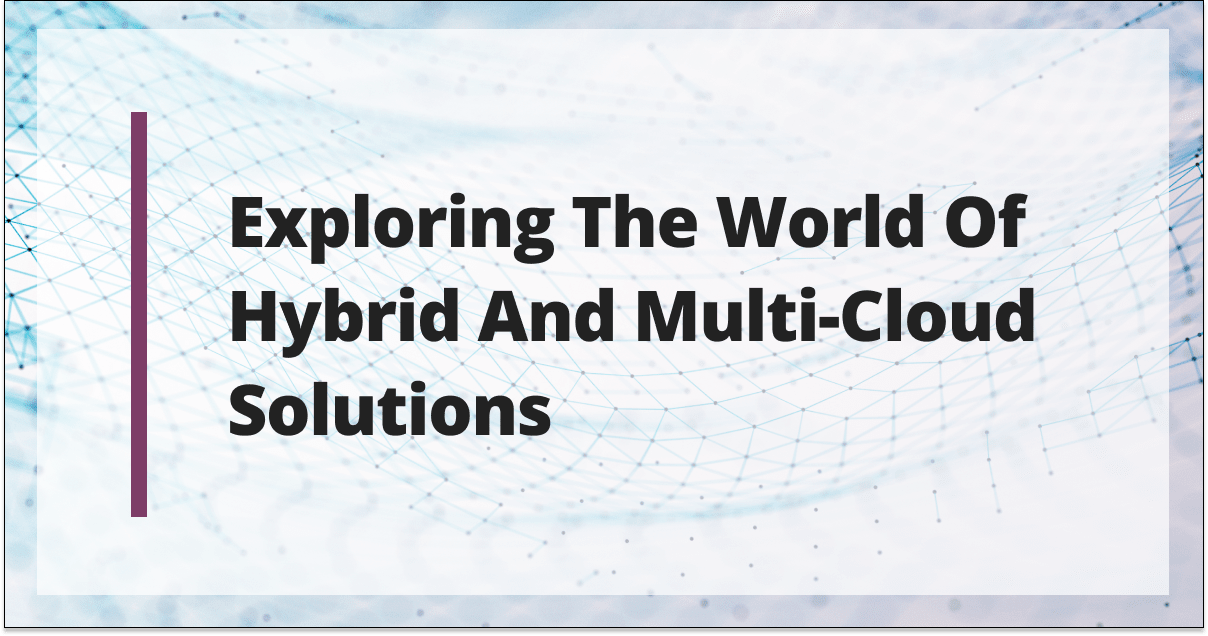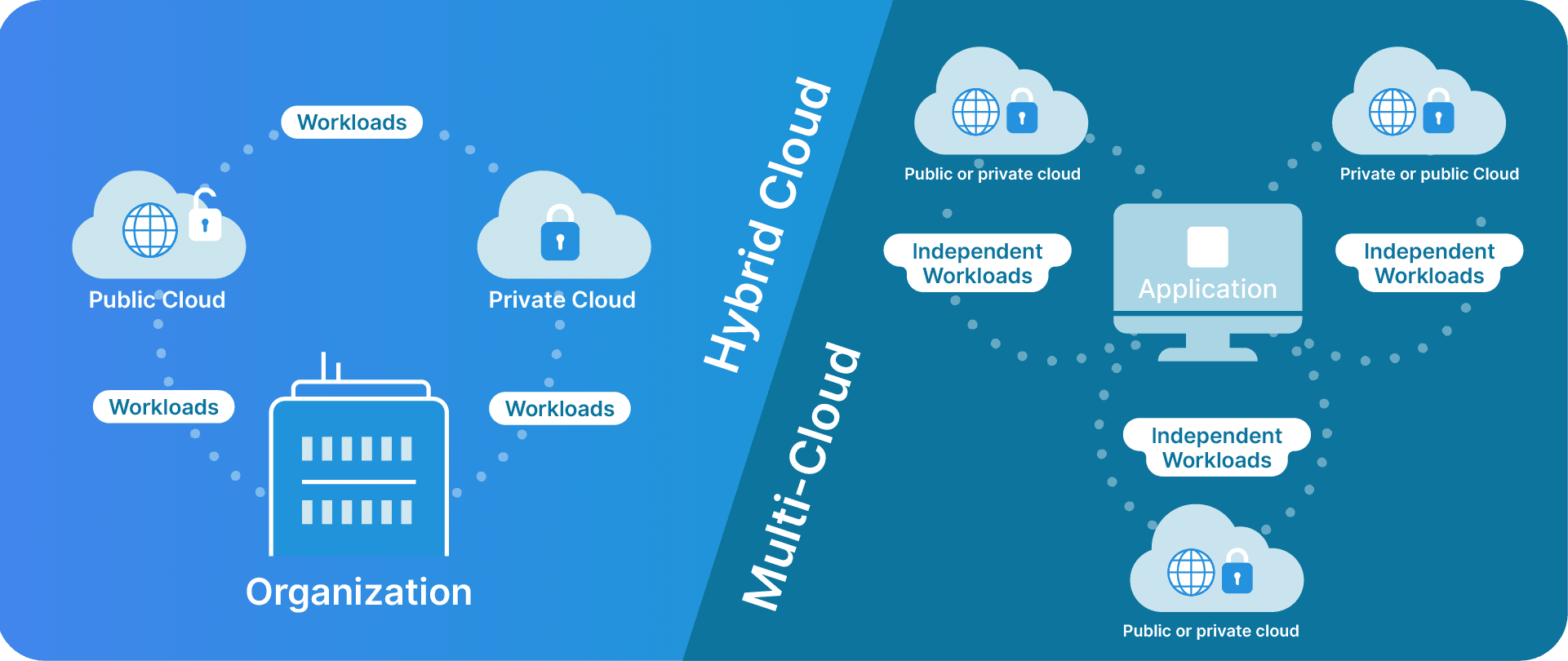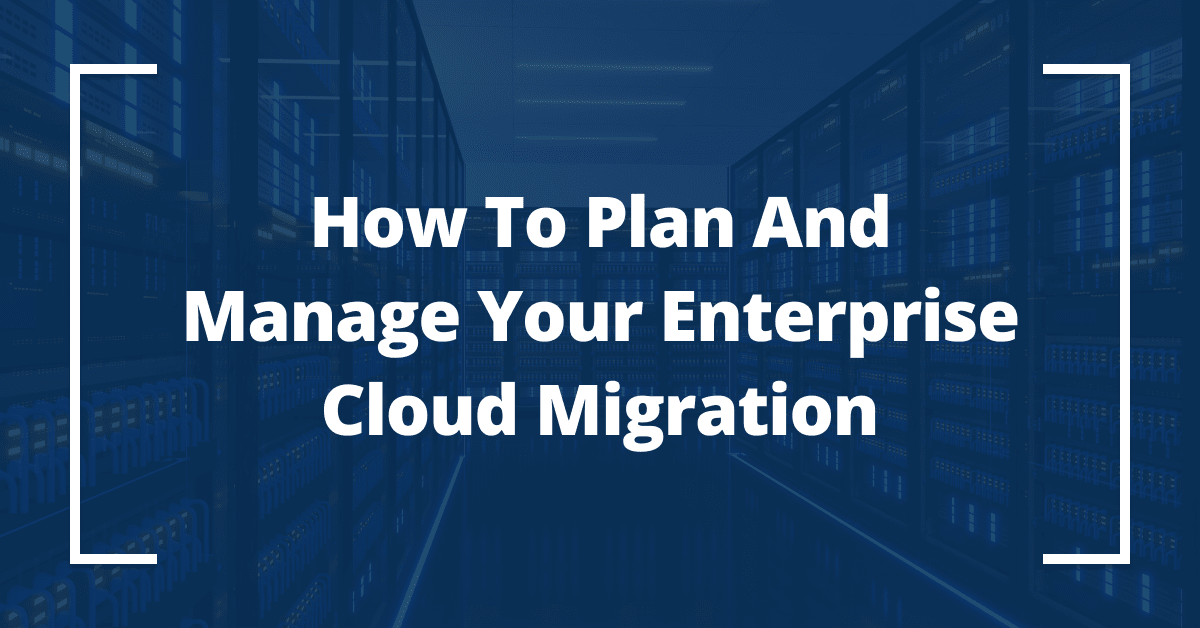
Are you pondering over hybrid and multi-cloud solutions, wondering which option would best meet your technological needs? Choosing the right path in the cloud landscape can significantly boost your IT infrastructure’s flexibility, cost-efficiency, and redundancy.
Given the multitude of choices, aligning your decisions with your unique workload requirements and data security needs is vital. This article aims to clarify the differences, benefits, potential hurdles, and real-world uses of both hybrid and multi-cloud solutions.
Read on to gain valuable insights that can advance your understanding and guide you in choosing the cloud strategy that seamlessly fits into your business blueprint.
Key points
- Cloud computing provides on-demand access to various computing resources via the Internet.
- Public cloud provides shared resources while private cloud offers dedicated infrastructure.
Differences between the two include customization, security, and scalability. - Hybrid cloud combines public and private clouds for flexibility and is suitable for varying workloads while multi-cloud uses multiple providers for flexibility and vendor diversification. Considerations for choosing between the two include workload, data sensitivity, compliance, and financial implications.
- Cloud management tools and strategies like service and security brokers, governance frameworks, automation, and continuos monitoring collectively enable businesses to successfully navigate the complexities of their cloud deployments.
- Liquid Web’s cloud hosting solutions offer scalability, resource isolation, and support for businesses navigating hybrid and multi-cloud complexities.
Introduction to cloud computing: A new era of technology
To understand the significance of cloud computing, we must first acknowledge its rich history. Although the term “cloud computing” may seem relatively new, its roots can be traced back to the 1950s.
Over the decades, cloud computing has undergone a remarkable evolution driven by key technological advancements. These include distributed systems, virtualization, Web 2.0, service orientation, and utility computing, all of which have collectively paved the way for developing cloud services as we know them today.
Today, cloud computing is characterized by its ability to provide on-demand access to a wide array of computing resources, including servers, storage, databases, networking, software, and more, all delivered over the Internet. This model for delivering computing services forms the foundation of cloud computing.
- Enabling the scaling of resources up or down as needed, ensuring optimal performance without incurring unnecessary costs.
- Eliminating the need for heavy upfront capital investments in physical infrastructure.
- Offering the flexibility to adapt swiftly to changing market conditions and customer demands.
Industries such as eCommerce, healthcare, education, and finance have all benefited from these advantages of cloud services. Cloud solutions enhance data management, accessibility, and operational efficiency, ultimately driving innovation and improving the quality of services delivered to end-users.
In the pursuit of optimizing cloud deployments, businesses are increasingly turning to hybrid and multi-cloud strategies. These two approaches leverage the public and private cloud deployment models and resources, allowing organizations to scale their computing infrastructure seamlessly, improve performance, and ensure high availability.
As the demand for always-on services continues to grow, understanding what public and private clouds are first becomes fundamental.
Public vs private cloud: Understanding the basics

Public cloud computing is characterized by the provision of IT resources, including servers, storage, and networking, by third-party service providers to multiple users over the internet. These services are made available over the Internet on a pay-as-you-go basis, often referred to as a utility pricing model.
Prominent public cloud providers include Liquid Web, Amazon Web Services (AWS), Microsoft Azure, and Google Cloud Platform (GCP).
A private cloud, on the other hand, is a cloud environment exclusively dedicated to a single organization. It can be hosted on-premises or by a third-party provider. Private clouds offer dedicated infrastructure, either on-premises or hosted by a provider, ensuring consistent performance and resource availability.
This isolation is well-suited for organizations with stringent performance and compliance requirements.
To sum it up, here’s an in-depth analysis of the key differences between the public and private cloud models:
| Public cloud | Private cloud | |
|---|---|---|
| Infrastructure | Shared resources (multi-tenant nature). | Dedicated resources (single-tenant architecture). |
| Accessibility | Accessible over the Internet. | Typically on-premises or hosted by a third-party service provider. |
| Ownership | Cloud service provider-owned. | Organization-owned (proprietary). |
| Customization | Less control over underlying infrastructures, fewer customization options compared to private clouds, and potential security concerns. | High degree of customization but the setup and maintenance are considerably more complex than its public counterpart. |
| Security | Provider-managed, user responsibility for data and applications. | User-controlled, highly customizable security. |
| Cost | Pay-as-you-go, variable cost. | Higher upfront costs, potentially lower long-term costs for stable workloads. |
| Scalability | Rapid scalability. | Scalability depends on available resources. |
| Suitable for | Startups with varying workloads. | Enterprises with stringent compliance requirements. |
| Implementation | Through cloud service providers like Liquid Web, AWS, Azure, and Google Cloud. | On-premises private cloud such as IBM Cloud Private. |
As you can see, public and private clouds are distinguishable in various ways; factors such as cost, control, security, and scalability could influence decisions toward either. If your business needs the strengths of both the public and private clouds, you’ll have to delve into hybrid cloud computing and multi-cloud architecture.
Hybrid and multi-cloud: The future of cloud computing
These statistics underscore an inevitable shift toward these two cloud approaches – but what are they exactly, and how might they benefit your organization?

Hybrid clouds
Hybrid cloud computing combines both public and private cloud resources into a single integrated infrastructure. It allows organizations to leverage the benefits of both environments, using public clouds for scalability and cost-effectiveness while keeping sensitive or critical data on a private cloud for security and compliance.
With hybrid clouds, businesses can align their resource usage with real-time needs by effortlessly transitioning workloads between cloud solutions. This empowers organizations to optimize costs while maintaining a sturdy performance. The hybrid model also improves compliance and security parameters, making it a superior choice for managing sensitive data.
Here are some of the pros and cons of hybrid clouds:
| Pros | Cons |
|---|---|
| Flexibility: Organizations can choose where to deploy specific workloads based on their requirements, optimizing performance and cost. | Complexity: Managing multiple environments can be challenging and may require specialized expertise. |
| Security: Sensitive data can be kept on a private cloud, providing better control and compliance with data privacy regulations. | Integration: Ensuring seamless communication and data transfer between public and private clouds can be complex. |
| Scalability: Hybrid clouds can handle sudden increases in demand by utilizing public cloud resources, ensuring smooth operations during traffic spikes. | Cost management: Keeping track of costs across multiple cloud providers and environments can be complicated. |
| Cost-efficiency: It allows cost-effective resource utilization by balancing the use of private and public cloud resources. | Vendor lock-in: There may still be some level of vendor lock-in, especially with private cloud solutions. |
Implementing a hybrid cloud requires specialized skills and tools to integrate and manage. Companies have to ensure data consistency and enforce stringent security policies across the public and private facets of their hybrid environment.
Multi-cloud
The multi-cloud involves using multiple public cloud providers simultaneously. Organizations might use different cloud providers for different purposes, such as AWS for machine learning, Azure for database services, and Google Cloud for analytics.
Multi-cloud offers flexibility, vendor diversification, and the ability to choose the best services from each provider. Organizations opting for a multi-cloud setup can sidestep the pitfalls of vendor dependency, gaining advantages such as better performance, improved reliability, and far greater scope for flexibility.
Here’s an overview of the pros and cons of the multi-cloud setup:
| Pros | Cons |
|---|---|
| Vendor diversification: Reduces reliance on a single cloud provider, reducing the risk of service disruptions and vendor-specific issues. | Complexity: Managing multiple cloud providers can be complex and may require specialized skills and tools. |
| Best-of-breed services: Organizations can choose the best services from different providers for specific tasks, optimizing performance and functionality. | Interoperability: Ensuring compatibility and data transfer between different clouds can be challenging. |
| Redundancy: Multi-cloud setups can enhance redundancy and disaster recovery capabilities by distributing resources across different providers. | Cost management: Tracking and optimizing costs across multiple providers can be complicated and require dedicated efforts. |
| Competitive pricing: Organizations can take advantage of competitive pricing and discounts offered by different cloud providers. | Data transfer costs: Transferring data between cloud providers can incur additional costs, especially for large datasets. |
In the multi-cloud terrain, seamless integration and communication between different cloud providers can be complicated. Navigating the unique interfaces, billing models, and support structures of each provider can demand considerable effort and time.
Nevertheless, the challenges of both the hybrid cloud and multi-cloud setups are outweighed by the immense benefits they offer. Despite the steep learning curve, these strategies empower businesses to utilize a diverse range of cloud services without compromising on their individual requirements.
Can a hybrid cloud be a multi-cloud?
Although hybrid and multi-cloud strategies both involve the use of multiple clouds, they represent different approaches and should not be used interchangeably. Having a multi-cloud setup does not automatically mean you have a hybrid cloud.
However, there are specific scenarios where a hybrid cloud may overlap as a part of a multi-cloud strategy.
For example, a company might choose to utilize multiple public clouds tied harmoniously with its private cloud infrastructure. By leveraging a hybrid multi-cloud infrastructure, businesses can tap into higher performance, amplified security, and enriched flexibility.
Choosing your path: When to use hybrid cloud and multi-cloud infrastructures
The choice between a hybrid or a multi-cloud infrastructure hinges upon thoughtful consideration of several pivotal factors, each bearing its own weight depending on your organization’s specific requirements and goals:
- Requirements of your workloads and applications: This encompasses scalability, data sensitivity, and expected performance.
- Level of control and security needed for your data: If you’re dealing with data of a sensitive nature where stringent security provisions are indispensable, this is a crucial aspect.
- Industry and regulatory compliance standards: You have to ensure that the strategy you choose abides by the rules and laws of your business sphere.
- Financial implications: This includes not just the direct cost of services but also hidden costs pertaining to management-related affairs, calculating the Total Cost of Ownership (TCO) for each model, and the potential costs ensuing from vendor lock-in.
- Skills and qualifications: Analyze the skill set that your team brings to the table. Do they possess the necessary capabilities to manage and operate the chosen cloud environment adeptly? Do you have room in your resources for additional training or expertise if required?
Factors favoring a hybrid cloud model
A hybrid cloud becomes particularly attractive when your enterprise needs to balance cost and efficiency with data security and compliance requirements.
Use case 1: A financial services firm that needs to store sensitive customer data in a private cloud for compliance needs while exploiting the scalability of public cloud resources for non-sensitive operations.
Use case 2: An eCommerce business with workloads that fluctuate seasonally.
In such instances, a hybrid cloud strategy can allow scaling resources dynamically in the public cloud during high-demand periods and maintaining cost-efficient private cloud resources when demand subsides.
Factors favoring a multi-cloud model
A multi-cloud infrastructure stands out as the better alternative when a business seeks to avoid vendor lock-in, craves increased flexibility, or needs to exploit specific capabilities from different cloud solution providers.
Use case 1: A technology company wanting to harness AWS’s renowned machine learning services, Azure’s solid analytics, and Google Cloud’s adept handling of big data processing. Here, a multi-cloud strategy would be highly beneficial, allowing the enterprise to leverage the strengths of various cloud providers for different services.
Use case 2: Enterprises often choose a multi-cloud infrastructure to pick region-specific providers and meet local performance and compliance requirements while maintaining a centralized control strategy. Such an approach combines the advantages of localized provision and global oversight effectively.
By weighing these considerations and use cases, you can shape an informed strategy that captures the unique strengths of hybrid or multi-cloud approaches.
Effective cloud management serves as an anchor for achieving optimal cost, security, performance, and compliance. By streamlining operations using vigorous cloud management tools and strategies, businesses can navigate the complexities of their deployments and achieve their operational goals effectively.
Commonly used tools for cloud management
- Cloud Management Platforms (CMPs) offer a unifying management interface for public, private, and hybrid cloud services.
- Cloud Service Brokers (CSBs) function as intermediaries that negotiate relationships between cloud service providers and consumers, thereby bringing simplicity and manageability to multi-cloud strategies.
- Cloud Access Security Brokers (CASBs) sit between users and cloud applications, providing security enforcement points to mitigate risks and ensure compliance.
Strategies for effective cloud management
- Implementing a governance framework that is comprehensive and vigorous to oversee resource utilization, cost management, and performance optimization.
- Automating repetitive manual tasks to cut operational expenses and reduce time to market.
- Continuous monitoring measures to track cloud usage, performance, and overall health of your cloud environment.
Liquid Web’s cloud server hosting can help businesses adapt their infrastructure to fluctuating workloads seamlessly with its instant provisioning and scalability capabilities. This makes it an apt solution for handling variable demands in both hybrid and multi-cloud environments. Even better, Liquid Web’s cloud-dedicated servers provide:
- Resource isolation similar to traditional dedicated servers – this way, workloads in complex cloud setups can maintain the essential performance boundaries and enriched security.
- A variety of server configurations for both Linux and Windows to optimize performance while meeting specific needs.
- Flexibility in selecting resources that align with your budget and requirements to promote cost optimization in hybrid and multi-cloud contexts.
- Round-the-clock support to aid organizations in navigating the complexities associated with hybrid and multi-cloud management.
By harnessing powerful cloud management strategies and the unique capabilities offered by services like Liquid Web’s cloud server hosting, businesses can confidently steer the ship in the vast expanse of hybrid and multi-cloud computing, charting their course towards greater operational success and growth.
Implementing your cloud strategy with confidence
Navigating the complex world of hybrid and multi-cloud strategies in cloud computing can seem intimidating. However, success often emerges from understanding the nuances and carefully selecting solutions that enhance your business performance.
Opt for a cost-effective hybrid cloud solution if your business requires the flexibility to toggle between a public cloud and a private cloud based on workload needs and data security.
On the flip side, if you need diverse offerings from multiple cloud vendors, a multi-cloud environment that enriches reliability and performance while reducing vendor dependence could be the answer.
And remember, your strides toward transforming your business with hybrid or multi-cloud strategies need resilient expertise and support.
Liquid Web’s cloud server hosting supports your business goals through seamless scalability and dedicated resources for optimal performance, offering a range of server configurations and strict security measures. Even better, Liquid Web ensures a smooth transition with free migrations to help businesses effortlessly make the switch to their chosen cloud infrastructure.
Now, it’s time to elevate your business potential with the cloud. Liquid Web’s team is ready to help you leverage your desired cloud computing approach with innovative solutions that are custom-made to align with your distinctive business goals.
[ad_2]
Source link






